Effects of Surface Crack Shape on Fracture Behavior of Oil Pipelines Based on the MMC Criterion
Abstract
:1. Introduction
2. Overview of the MMC Model
3. MMC Parameter Calibrations
3.1. Experimental Programs
3.2. Specimen Design
3.3. MMC Parameter Calibration at Failure Initiation
3.4. Mesh Size Sensitivity Analysis
4. Finite Element Program for Pipe Wide Plate
4.1. Geometric Dimensions and Boundary Conditions
4.2. Mesh Model
5. Results and Discussions
5.1. Pipe Wide Plate Fracture Process
5.2. Effect of Crack Shape on the Tensile Properties of Pipeline Wide Plate
5.3. Effect of Surface Crack Size on the Location of Crack Initiation in Wide Plates
6. Conclusions
- (1)
- Fracture performance experiments were conducted under monotonic loading, coupled with finite element analysis. Using a phenomenological hybrid numerical-experimental calibration method, the fracture parameters of the MMC model were established as C1 = 0.0187, C2 = 496.56, and C3 = 0.8864.
- (2)
- At the critical section with equivalent cross-sectional areas, circular cracks exhibited an earlier sudden load decrease compared to elliptical cracks, indicating a reduced load-bearing capacity for circular cracks. Elliptical cracks predominantly extended in the thickness direction, whereas circular cracks demonstrated relatively consistent propagation distances in various directions.
- (3)
- With a constant crack length, as the crack depth increased, the displacement at the point of the sudden load drop gradually diminished. In the cumulative damage process at the crack front, the elliptical crack front with a depth less than half of the wall thickness (a = 5 mm) exhibited the highest damage accumulation at its midpoint. Conversely, for the circular crack front with a depth greater than half of the wall thickness (a = 25 mm), the highest damage accumulation occurred near the inner measurement point of the wide plate. Additionally, under uniform displacement increment before crack initiation, the damage increment of the elliptical crack with a = 5 mm gradually decreased, whereas the increment value of the circular crack with a = 25 mm gradually increased.
Author Contributions
Funding
Institutional Review Board Statement
Informed Consent Statement
Data Availability Statement
Conflicts of Interest
References
- Ding, J.L.; Xi, X.; Zhang, D.H. Development and outlook of China’s pipeline transportation technologies under energy security strategy. Oil Gas Storage Transp. 2022, 41, 632–639. [Google Scholar] [CrossRef]
- Shi, L.Q.; Niu, H. Development of High-deformable Line Pipe Suitable for Strain-based Design. Welded Pipe Tube 2014, 5, 66–72. [Google Scholar] [CrossRef]
- Zhang, C.G.; Zheng, L.X.; Xie, S.Q. Recent developments of large diameter X80 UOE line pipes. Baosteel Tech. Res. 2014, 8, 46. [Google Scholar] [CrossRef]
- Bott, I.S.; Siciliano, F.; Batista, G.Z. Line Pipe Steels. In Handbook of Pipeline Engineering; Springer International Publishing: Cham, Switzerland, 2024; pp. 285–310. [Google Scholar]
- Witek, M. Possibilities of using X80, X100, X120 high-strength steels for onshore gas transmission pipelines. J. Nat. Gas Sci. Eng. 2015, 27, 374–384. [Google Scholar] [CrossRef]
- Yoo, J.Y.; Ahn, S.S.; Seo, D.H. New development of high grade X80 to X120 pipeline steels. Mater. Manuf. Process. 2011, 26, 154–160. [Google Scholar] [CrossRef]
- Zhang, Y.C.; Jiang, W.; Tu, S.T. Fracture toughness assessment of the X80 steel by nanoindentation technique and a modified constitutive model. Theor. Appl. Fract. Mech. 2022, 117, 103195. [Google Scholar] [CrossRef]
- Peng, Z.; Zhao, H.; Li, X. Ductile fracture of X80 pipeline steel over a wide range of stress triaxialities and Lode angles. Eng. Fract. Mech. 2023, 289, 109470. [Google Scholar] [CrossRef]
- Schell, C.A.; Lever, E.; Groth, K.M. Strain-based design and assessment for pipeline integrity management: A review of applications and gaps. Int. J. Press. Vessel. Pip. 2023, 204, 104973. [Google Scholar] [CrossRef]
- Tkaczyk, T.; O’Dowd, N.P.; Nikbin, K. Fracture assessment procedures for steel pipelines using a modified reference stress solution. J. Press. Vessel. Technol. 2009, 131, 031409. [Google Scholar] [CrossRef]
- Kim, Y.J.; Budden, P.J. Reference stress approximations for J and COD of circumferential through-wall cracked pipes. Int. J. Fract. 2002, 116, 195–218. [Google Scholar] [CrossRef]
- Jayadevan, K.R.; Østby, E.; Thaulow, C. Fracture response of pipelines subjected to large plastic deformation under tension. Int. J. Press. Vessel. Pip. 2004, 81, 771–783. [Google Scholar] [CrossRef]
- Budden, P.J. Failure assessment diagram methods for strain-based fracture. Eng. Fract. Mech. 2006, 73, 7–552. [Google Scholar] [CrossRef]
- Guarracino, F.; Fraldi, M.; Giordano, A. Analysis of testing methods of pipelines for limit state design. Appl. Ocean Res. 2008, 30, 297–304. [Google Scholar] [CrossRef]
- Lee, S.J.; Yoon, Y.C.; Hwang, S.S. Development of an Evaluation Method for the Compressive-Bending Plastic Buckling Capacity of Pipeline Steel Tube Based on Strain-Based Design N Structural Engineering and Construction. Procedia Eng. 2011, 14, 312–317. [Google Scholar] [CrossRef]
- Fairchild, D.P.; Kibey, S.A.; Tang, H. Continued advancements regarding capacity prediction of strain-based pipelines. In Proceedings of the 2012 9th International Pipeline Conference, Calgary, AL, Canada, 24–28 September 2012; Volume 45158, pp. 297–305. [Google Scholar] [CrossRef]
- Gruben, G.; Hopperstad, O.S.; Børvik, T. Evaluation of uncoupled ductile fracture criteria for the dual-phase steel Docol 600DL. Int. J. Mech. Sci. 2012, 62, 133–146. [Google Scholar] [CrossRef]
- Nouira, M.; Oliveira, M.C.; Khalfallah, A. Comparative fracture prediction study for two materials under a wide range of stress states using seven uncoupled models. Eng. Fract. Mech. 2023, 279, 108952. [Google Scholar] [CrossRef]
- Li, R.; Zheng, Z.; Zhan, M. Fracture prediction for metal sheet deformation under different stress states with uncoupled ductile fracture criteria. J. Manuf. Process. 2022, 73, 531–543. [Google Scholar] [CrossRef]
- Bai, Y.; Wierzbicki, T. A new model of metal plasticity and fracture with pressure and Lode dependence. Int. J. Plast. 2008, 24, 1071–1096. [Google Scholar] [CrossRef]
- Lou, Y.; Huh, H. Prediction of ductile fracture for advanced high strength steel with a new criterion: Experiments and simulation. J. Mater. Process Technol. 2013, 213, 1284–1302. [Google Scholar] [CrossRef]
- Han, P.H.; Cheng, P.; Yuan, S. Characterization of ductile fracture criterion for API X80 pipeline steel based on a phenomenological approach. Thin Walled Struct. 2021, 164, 107254. [Google Scholar] [CrossRef]
- Yang, Y.; Liu, X.; Wu, K. Full-scale experimental investigation of the fracture behaviours of welding joints of APL X80 wide plate based on DIC technology. Eng. Fail. Anal. 2022, 131, 105832. [Google Scholar] [CrossRef]
- Fairchild, D.P.; Crapps, J.M.; Cheng, W. Full-Scale pipe strain test quality and safety factor determination for strain-based engineering critical assessment. In Proceedings of the 2016 11th International Pipeline Conference, ASME, Calgary, AL, Canada, 26–30 September 2016. [Google Scholar] [CrossRef]
- Nourpanah, N.; Taheri, F. Development of a reference strain approach for assessment of fracture response of reeled pipelines. Eng. Fract. Mech. 2010, 77, 2337–2353. [Google Scholar] [CrossRef]
- Dinovitzer, A.S.; Smith, R.J. Strain-based pipeline design criteria review. In Proceedings of the 1998 2nd International Pipeline Conference, ASME, Calgary, AL, Canada, 7–11 June 1998; Volume 40238, pp. 763–770. [Google Scholar] [CrossRef]
- Verstraete, M.; Waele, W.; Denys, R. Pressure correction factor for strain capacity predictions based on Curved Wide Plate testing. In Proceedings of the 2012 9th International Pipeline Conference, ASME, Calgary, AL, Canada, 24–28 September 2012; Volume 45158, pp. 359–365. [Google Scholar] [CrossRef]
- Zhu, X.K.; McGaughy, T.A. review of fracture toughness testing and evaluation using sent specimens. In Proceedings of the 2014 10th International Pipeline Conference, ASME, Calgary, AL, Canada, 9 September–3 October 2014. [Google Scholar] [CrossRef]
- Gong, B.; Wan, X.; Huo, X. Development of a strain-based fracture assessment approach for X80 steel pipe welded girth by modified Mohr-Coulomb model. Int. J. Press. Vessel. Pip. 2023, 206, 105056. [Google Scholar] [CrossRef]
- Wu, H.; Zhong, Z.; Benseddiq, N. Numerical simulation of the crack shape for the thermo-mechanical loaded valve. Eng. Fail. Anal. 2011, 18, 1487–1495. [Google Scholar] [CrossRef]
- Jin, Z.; Wang, X. Weight functions for the determination of stress intensity factor and T-stress for semi-elliptical cracks in finite thickness plate. Fatigue Fract. Eng. Mater. Struct. 2013, 36, 1051–1066. [Google Scholar] [CrossRef]
- Wang, S.; Wang, B.; Janin, Y.J. Effects of the surface crack shape on J values along the front of an elliptical crack. Fatigue Fract. Eng. Mater. Struct. 2021, 44, 2944–2961. [Google Scholar] [CrossRef]
- Ding, H.; Zhu, T.; Wang, X. An uncoupled ductile fracture model considering void shape change and necking coalescence. Eng. Fract. Mech. 2023, 292, 109612. [Google Scholar] [CrossRef]
- Baral, M.; Ripley, P.W.; Lou, Y. Anisotropic ductile fracture of a stainless steel under biaxial loading: Experiments and predictions. Int. J. Plast. 2024, 175, 103927. [Google Scholar] [CrossRef]
- Li, Y.; Wierzbicki, T. Prediction of plane strain fracture of AHSS sheets with post-initiation softening. Int. J. Solids Struct. 2010, 47, 2316–2327. [Google Scholar] [CrossRef]
- Seyyedi, S.E.; Gorji, H.; Mirnia, M.J. Prediction of ductile damage and fracture in the single-and multi-stage incremental hole-flanging processes using a new damage accumulation law. Int. J. Adv. Manuf. Technol. 2022, 119, 4757–4780. [Google Scholar] [CrossRef]
- Santos, I.D.S.; Sarzosa, D.F.B.; Paredes, M. Ductile fracture modeling using the modified Mohr–Coulomb model coupled with a softening law for an ASTM A285 steel. Thin Walled Struct. 2022, 176, 109341. [Google Scholar] [CrossRef]
- Xue, H.; Wang, Z.; Wang, S. Characterization of mechanical heterogeneity in dissimilar metal welded joints. Materials 2021, 14, 4145. [Google Scholar] [CrossRef] [PubMed]
- Loveday, M.S.; Gray, T.; Aegerter, J. Tensile Testing of Metallic Materials: A review. In Final Report of the TENSTAND Project of Work Package; NPL Management Ltd.: London, UK, 2004. [Google Scholar]
- Swift, H.W. Plastic instability under plane stress. J. Mech. Phys. Solids 1952, 1, 1–18. [Google Scholar] [CrossRef]
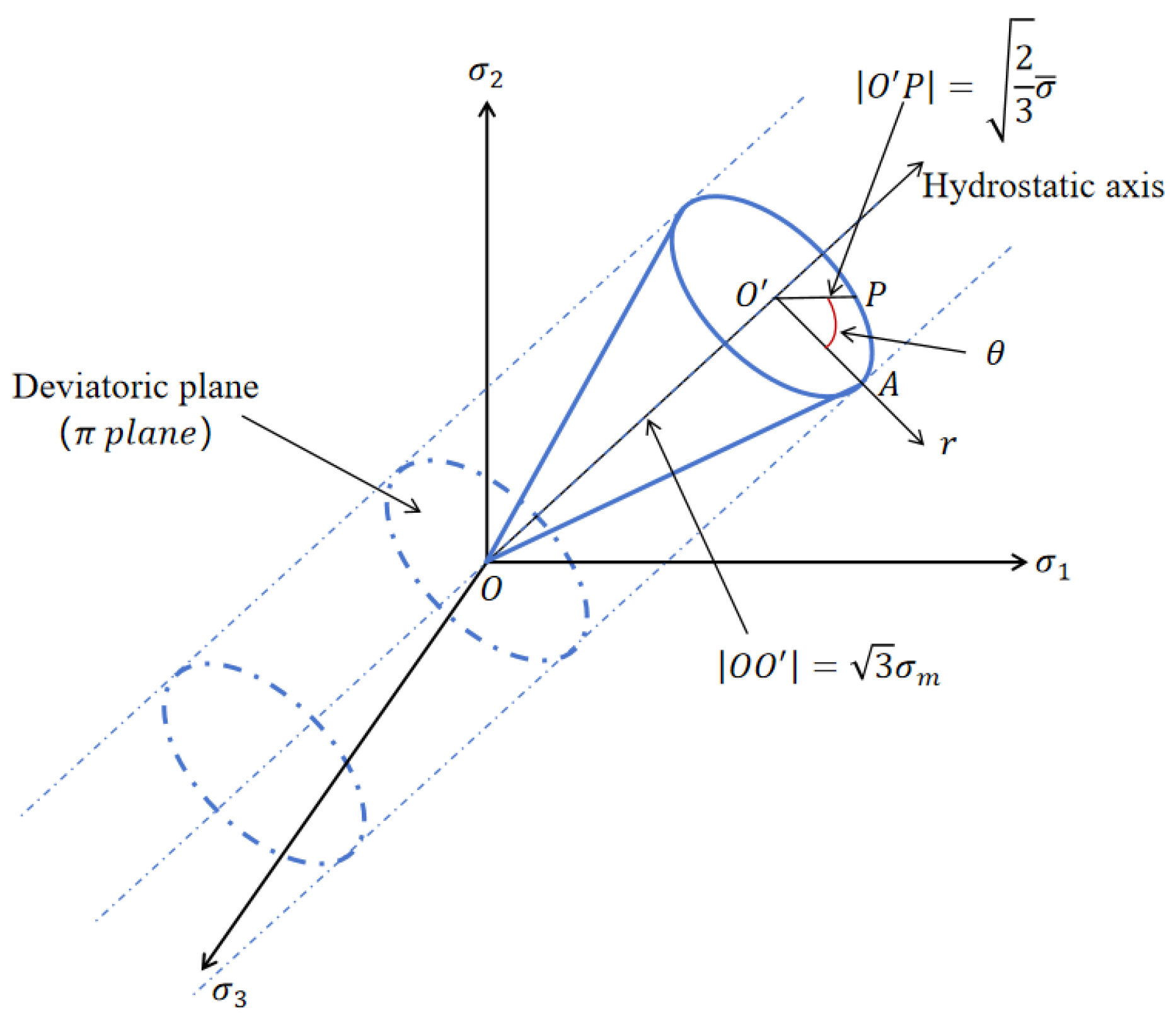
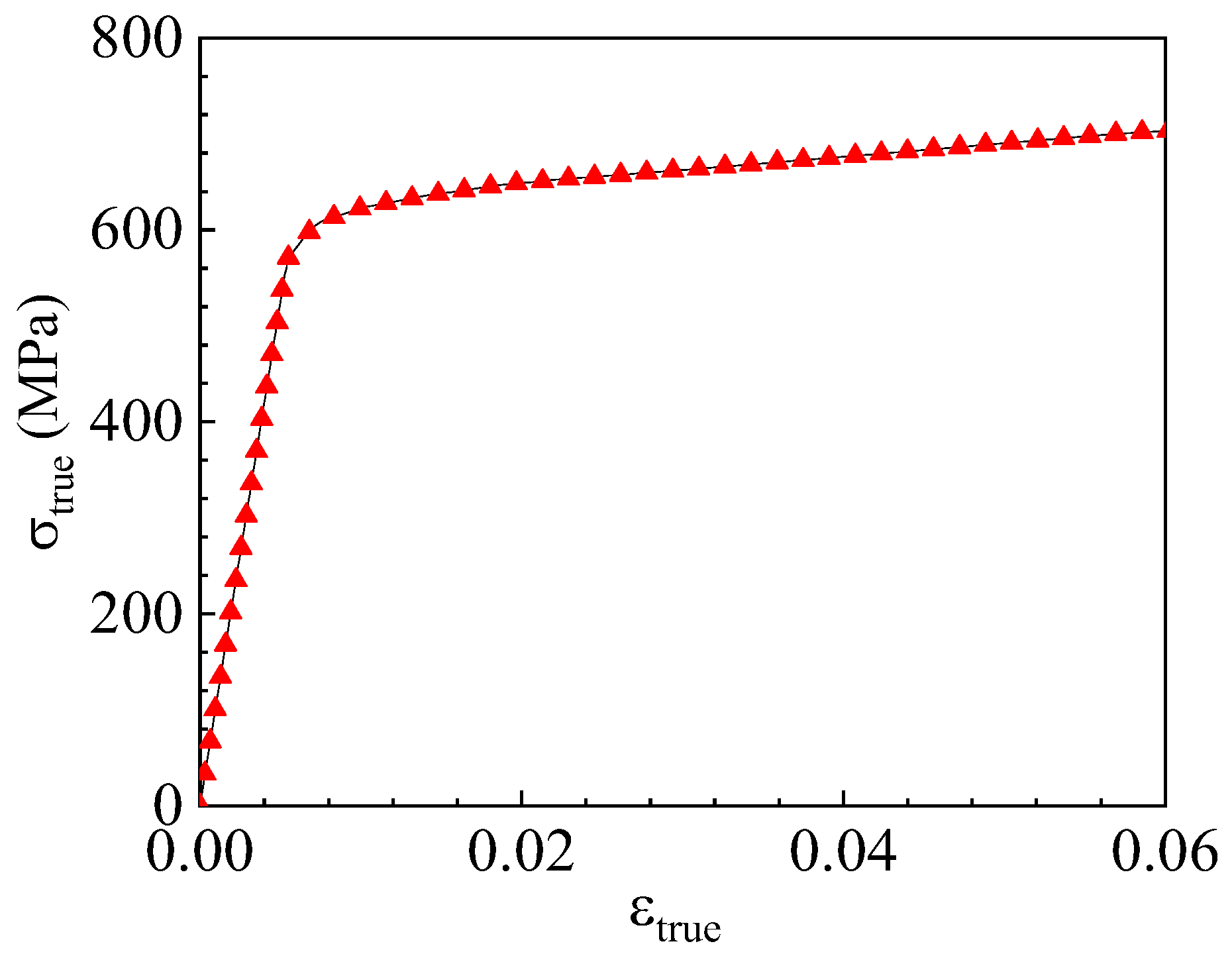
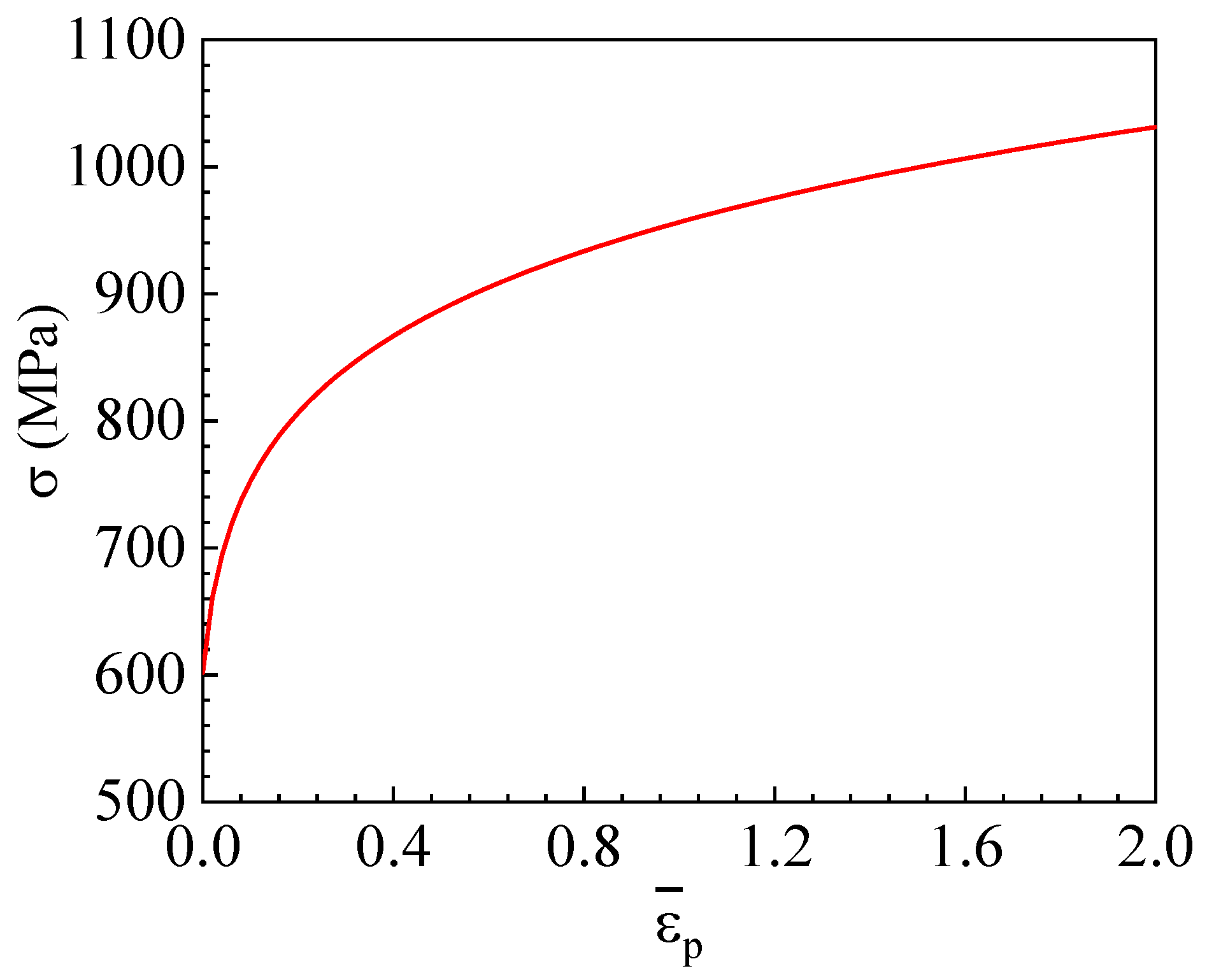
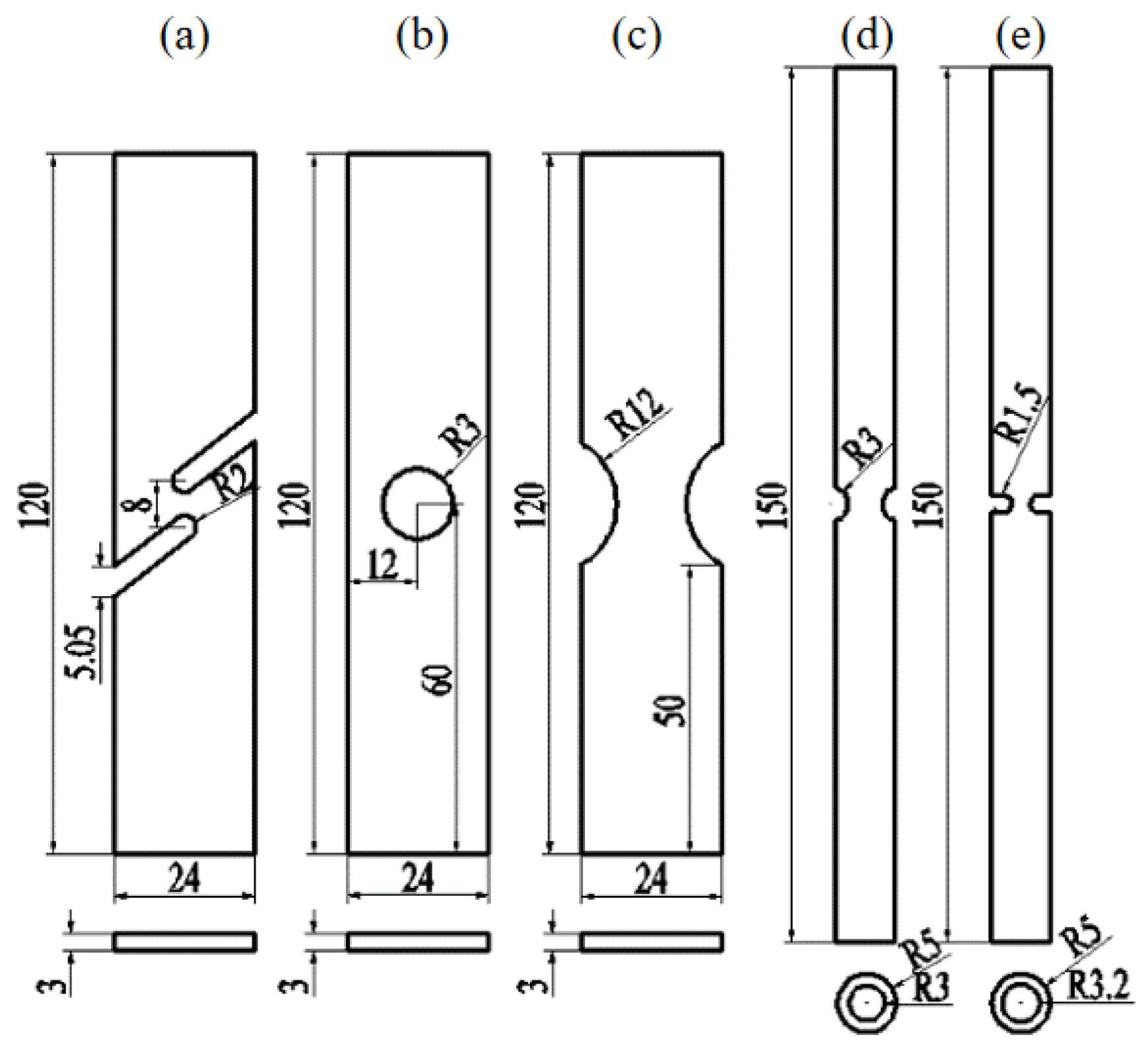
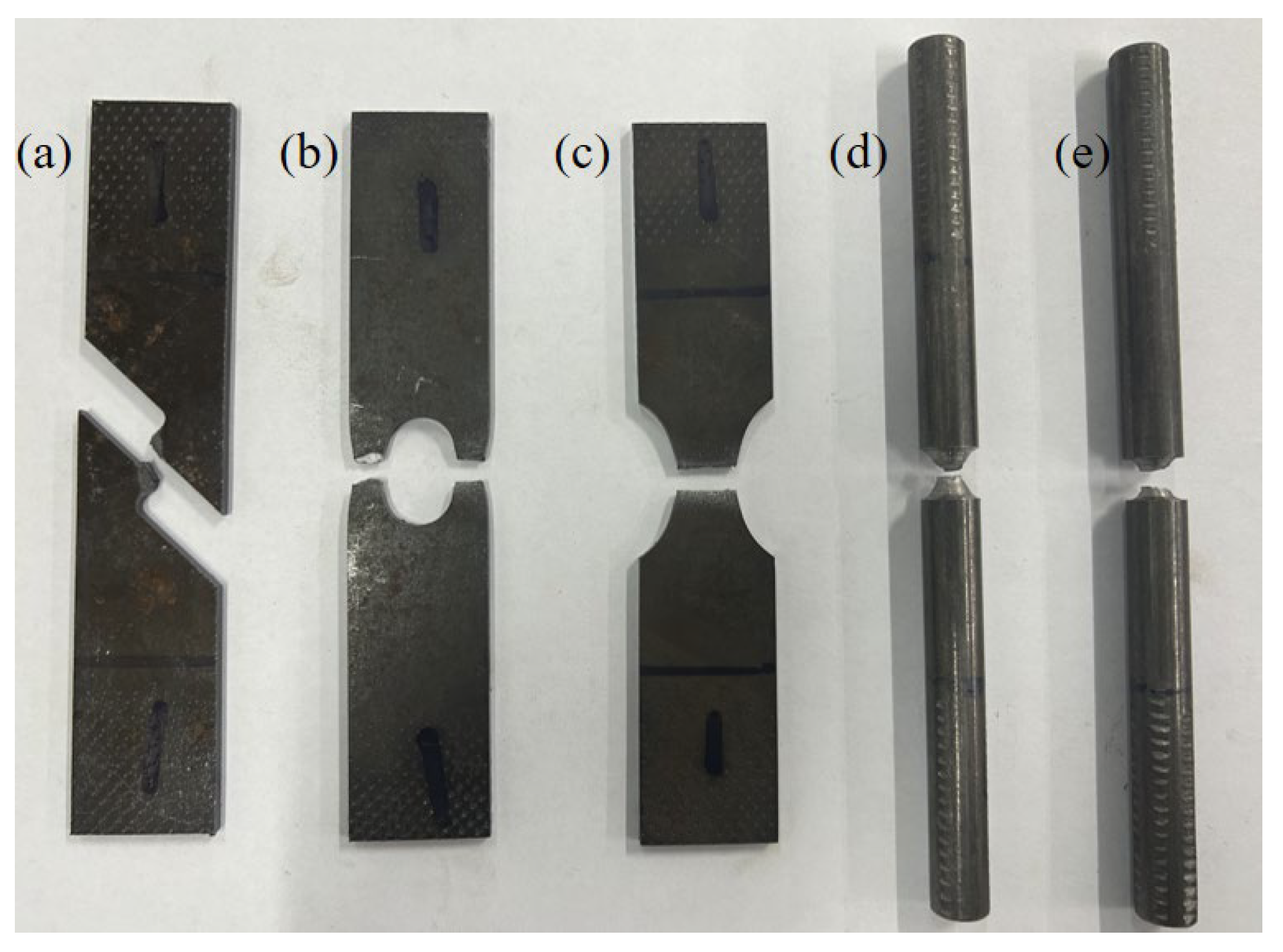
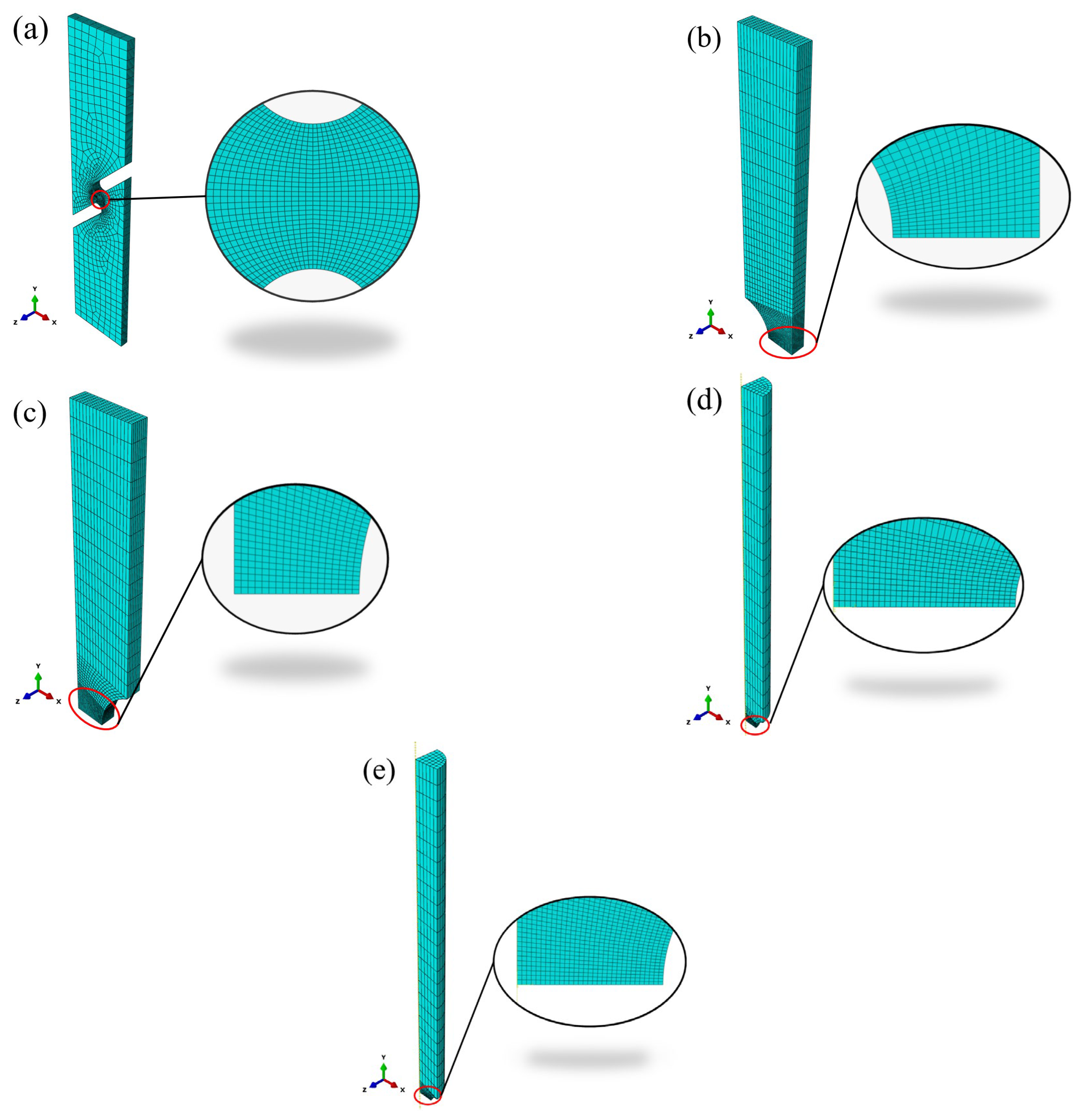
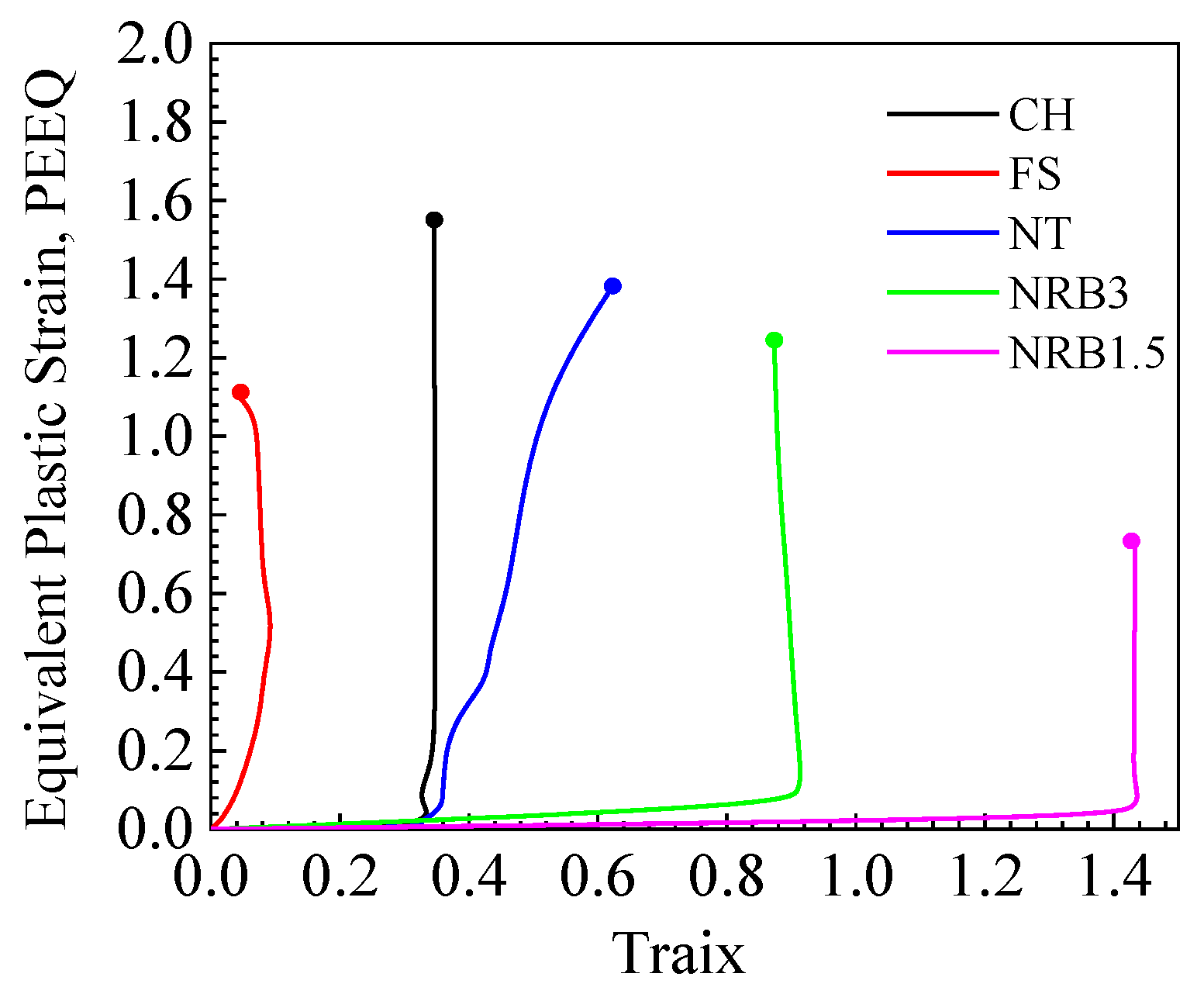

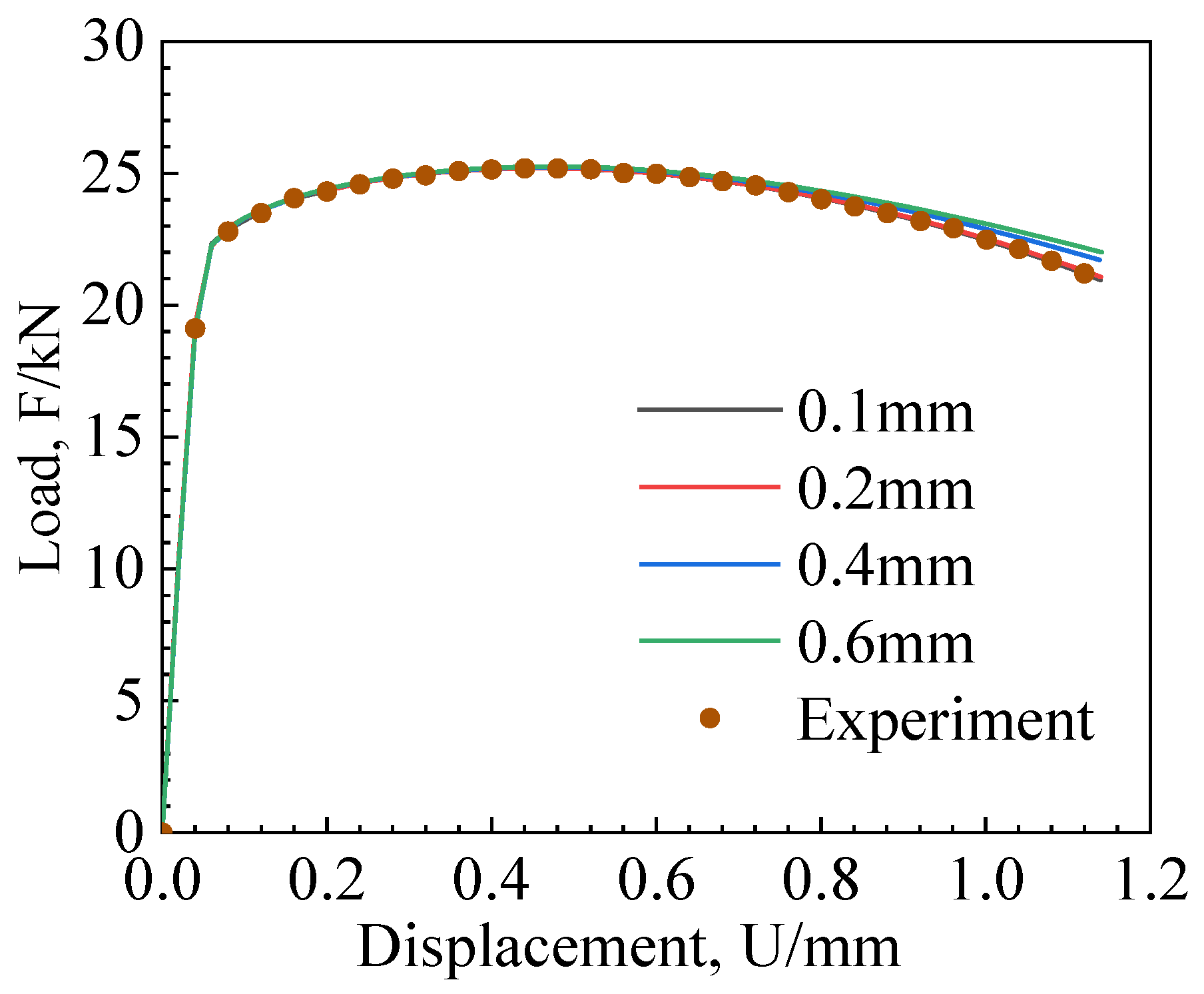



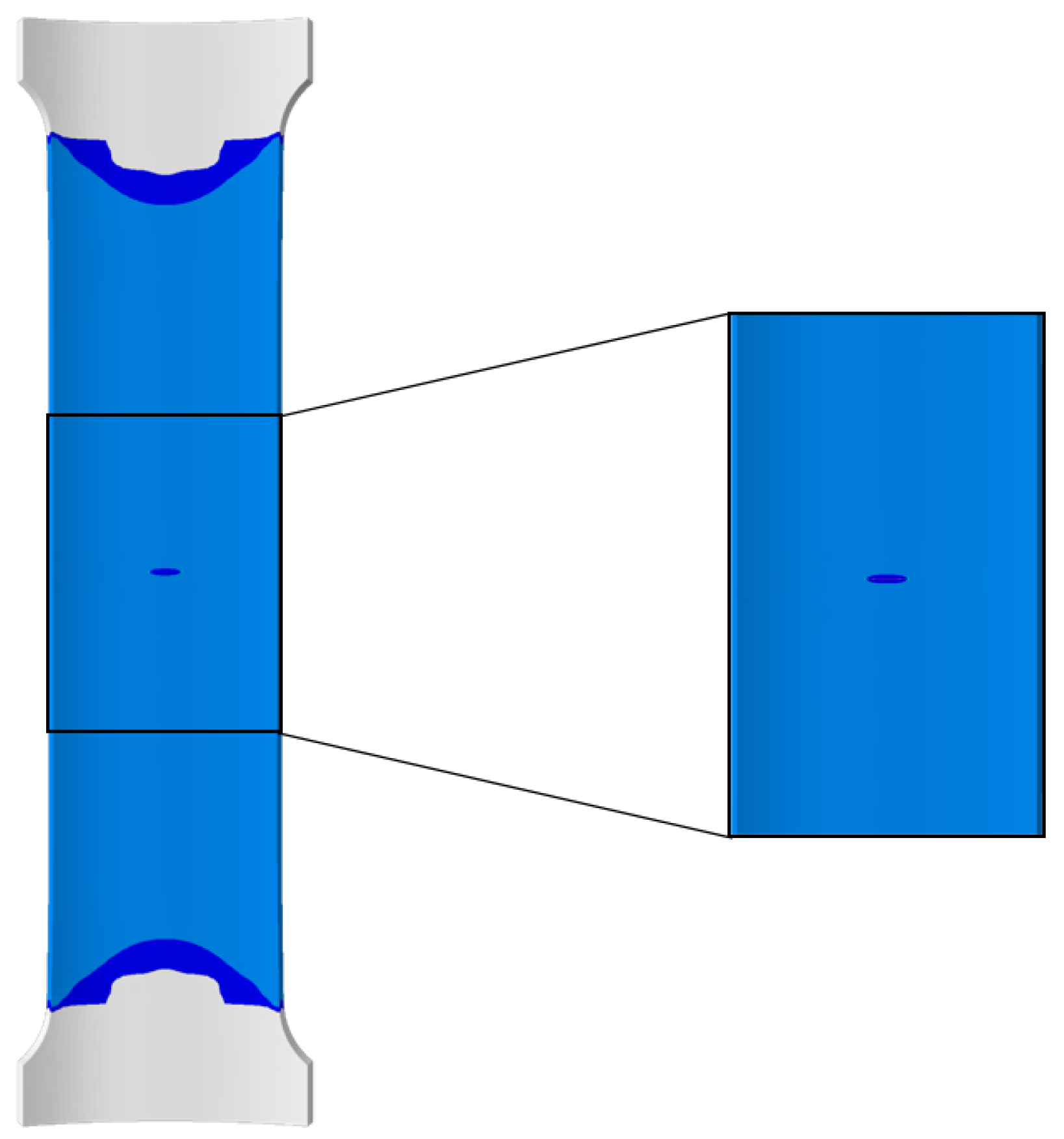
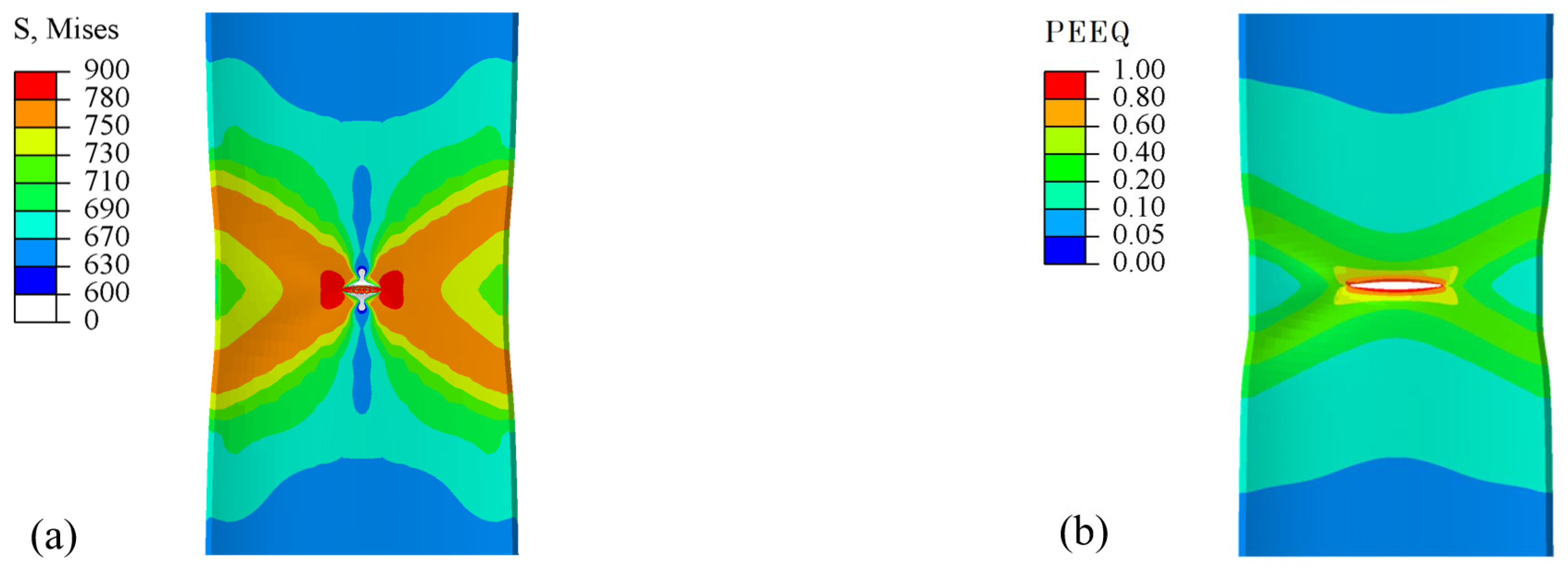

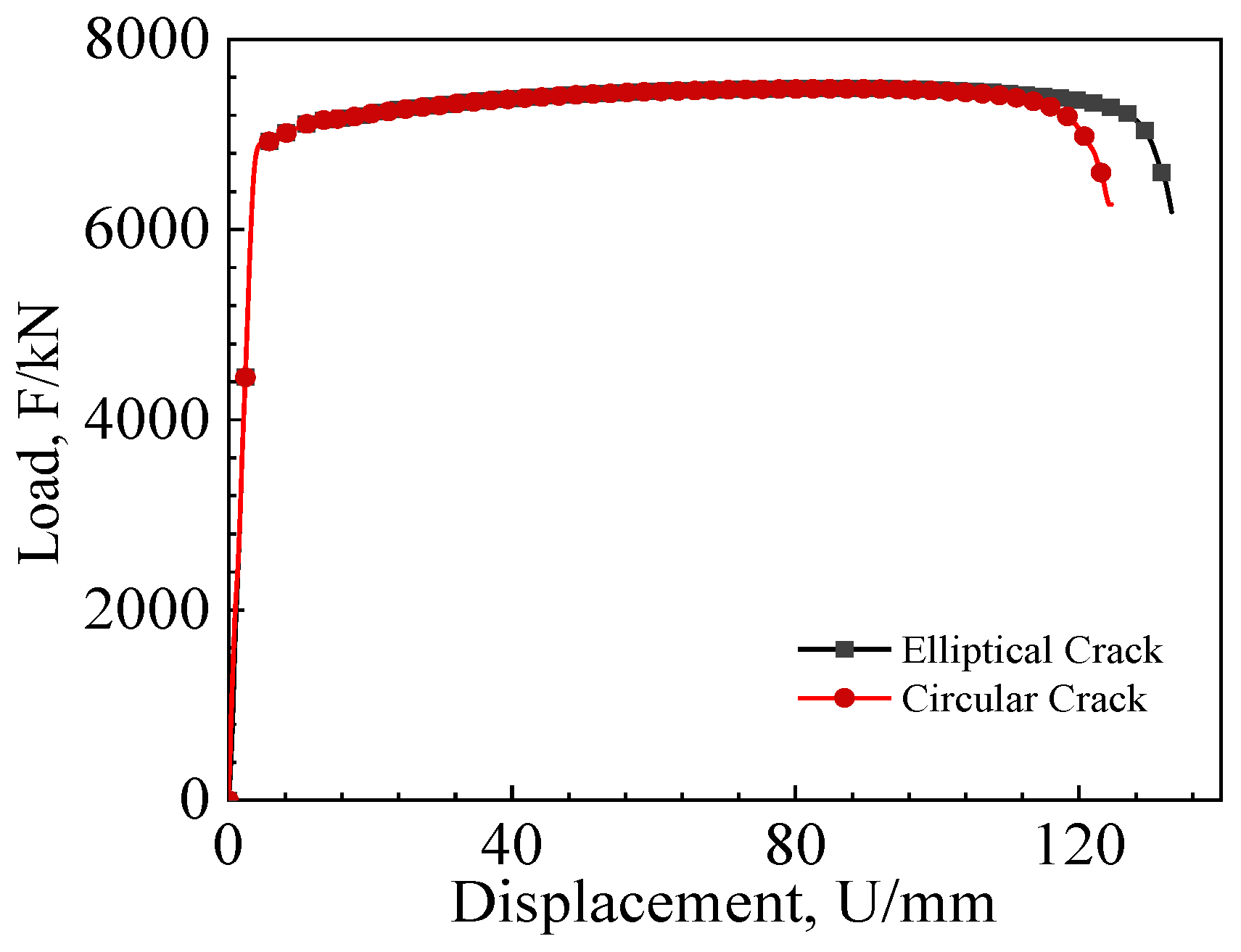
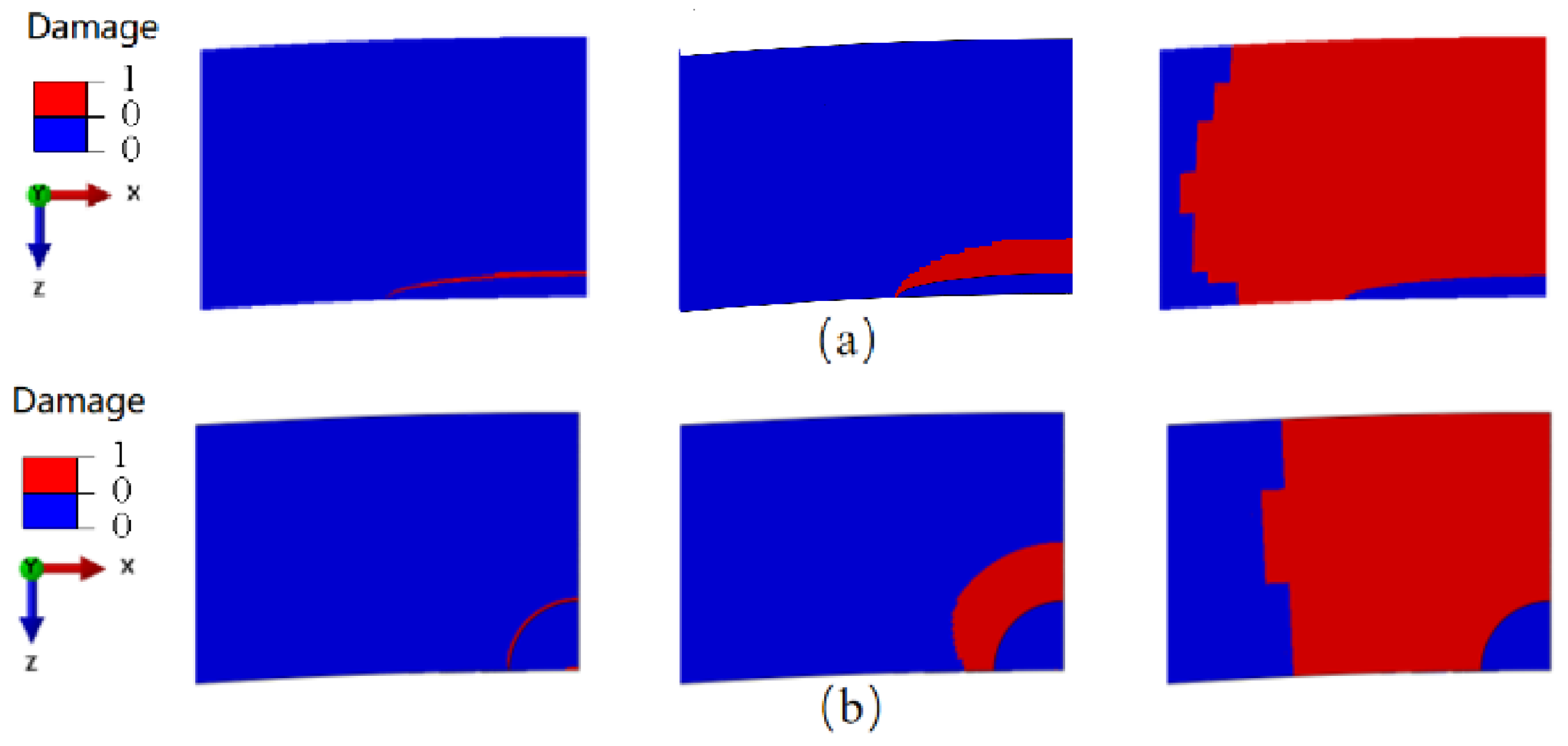
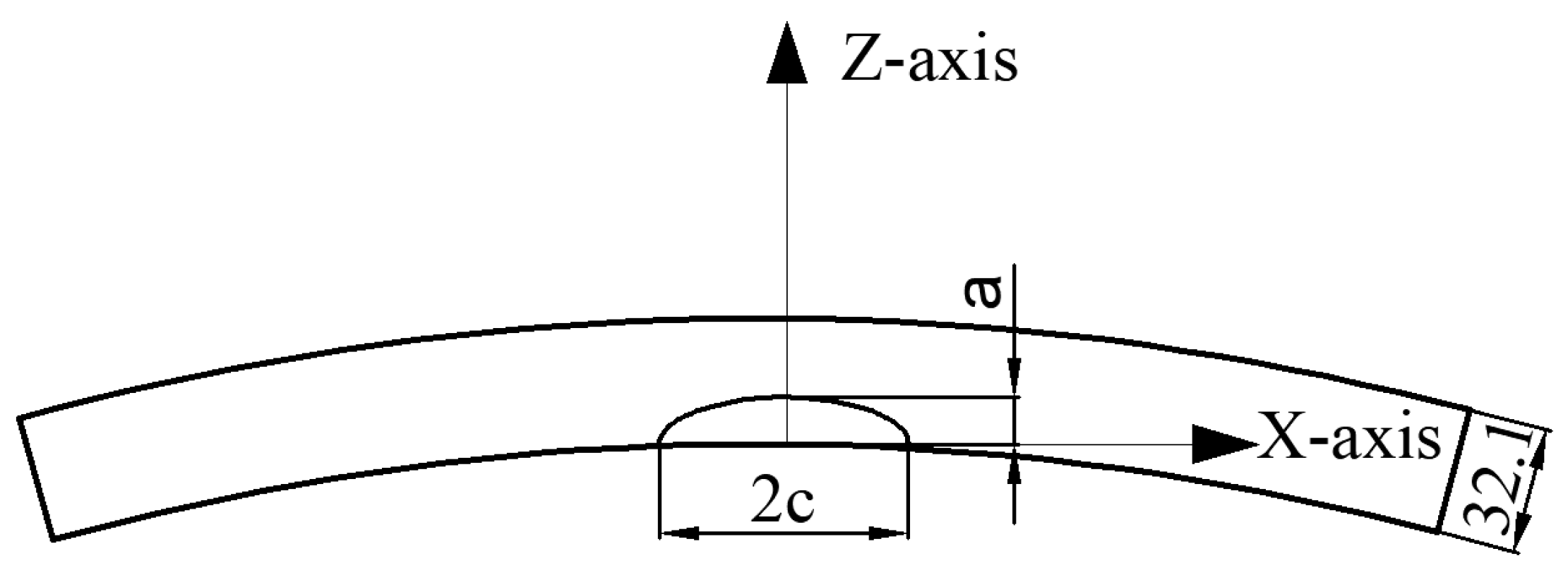
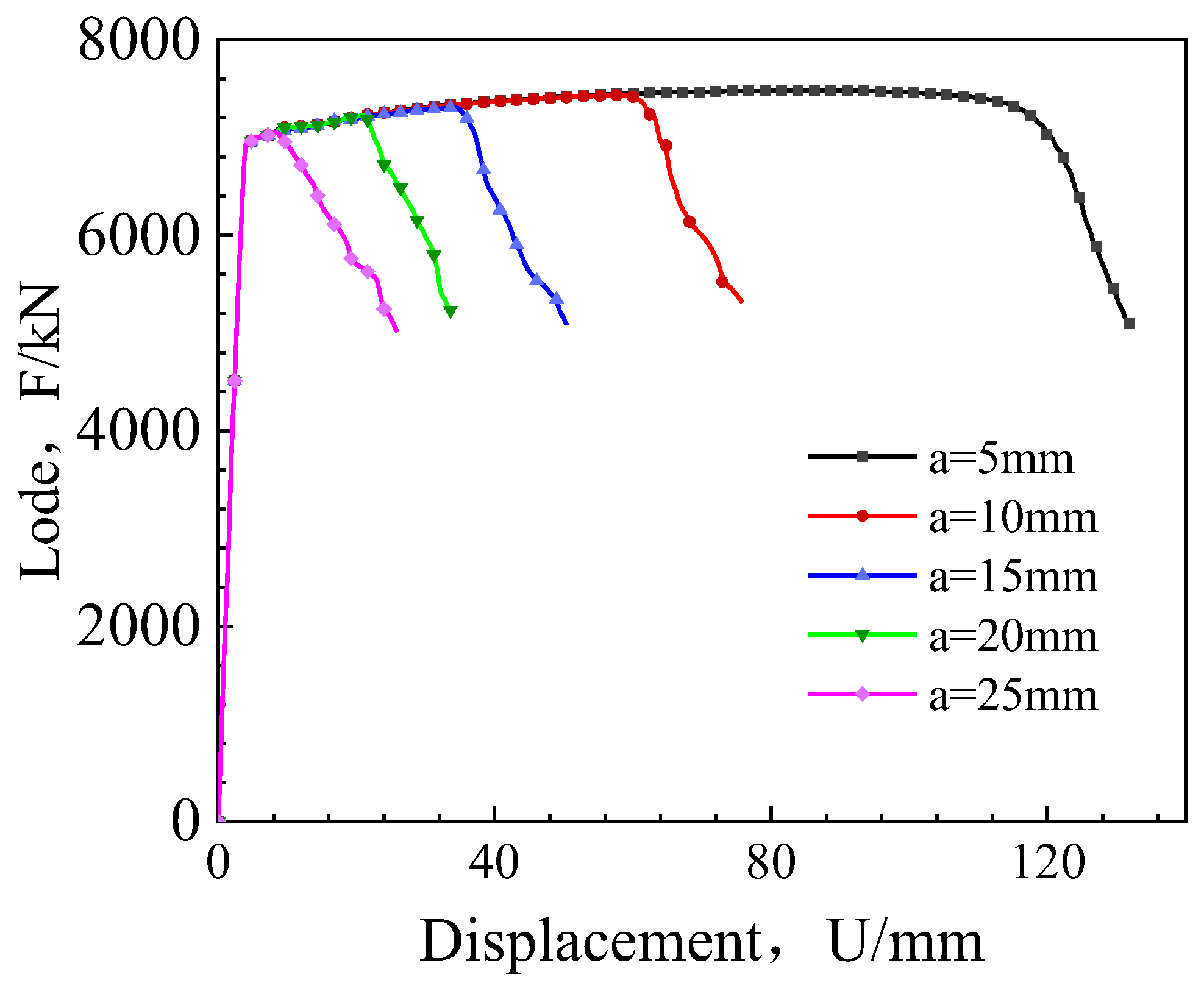
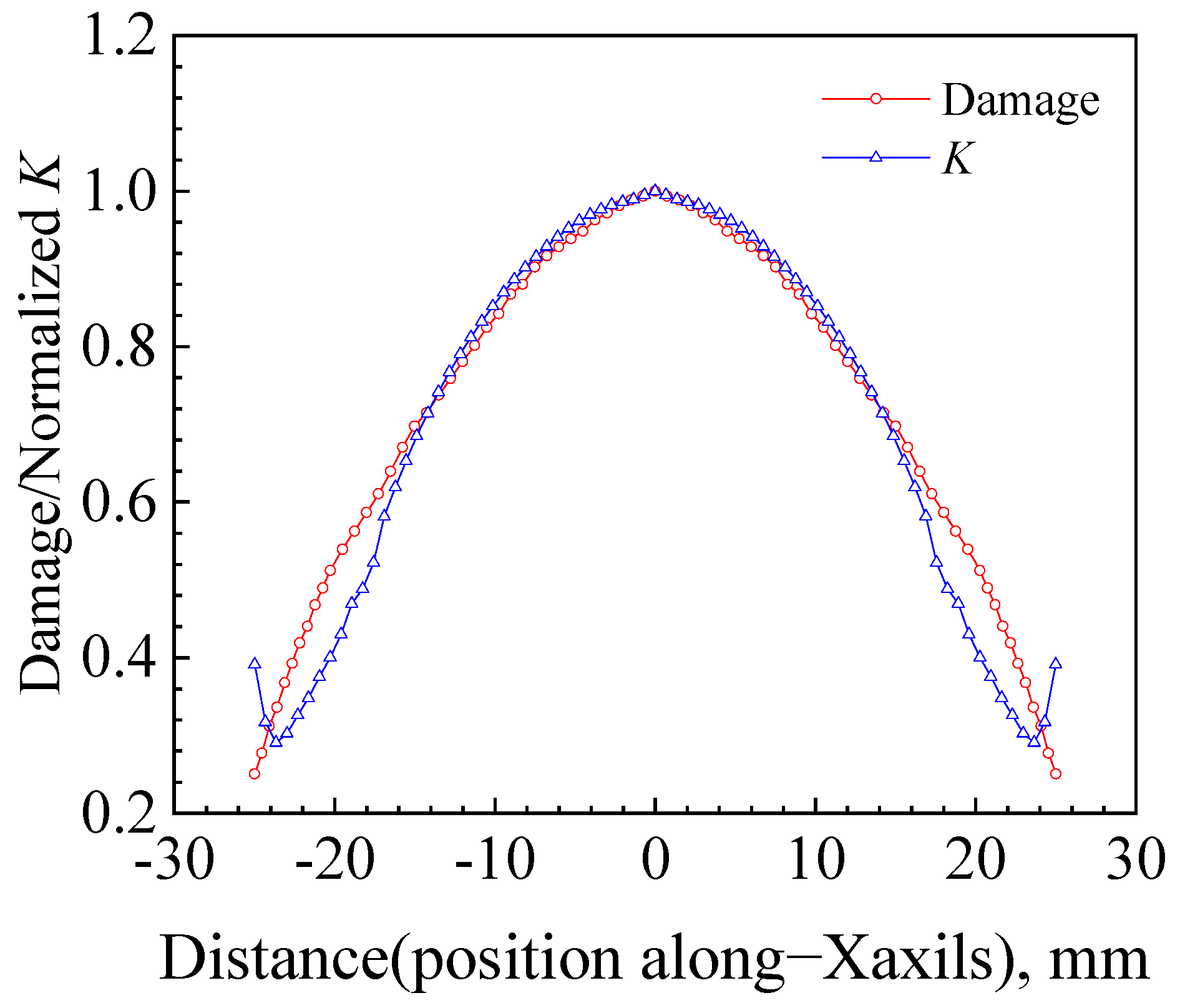



| Element | C | Si | Mn | P | S | Cr |
|---|---|---|---|---|---|---|
| wt% | 0.047 | 0.26 | 1.70 | 0.01 | 0.001 | 0.24 |
Disclaimer/Publisher’s Note: The statements, opinions and data contained in all publications are solely those of the individual author(s) and contributor(s) and not of MDPI and/or the editor(s). MDPI and/or the editor(s) disclaim responsibility for any injury to people or property resulting from any ideas, methods, instructions or products referred to in the content. |
© 2024 by the authors. Licensee MDPI, Basel, Switzerland. This article is an open access article distributed under the terms and conditions of the Creative Commons Attribution (CC BY) license (https://creativecommons.org/licenses/by/4.0/).
Share and Cite
Wu, J.; Gong, X.; Xue, H.; Wang, R.; Wang, Z. Effects of Surface Crack Shape on Fracture Behavior of Oil Pipelines Based on the MMC Criterion. Materials 2024, 17, 4406. https://doi.org/10.3390/ma17174406
Wu J, Gong X, Xue H, Wang R, Wang Z. Effects of Surface Crack Shape on Fracture Behavior of Oil Pipelines Based on the MMC Criterion. Materials. 2024; 17(17):4406. https://doi.org/10.3390/ma17174406
Chicago/Turabian StyleWu, Jun, Xiaoyan Gong, He Xue, Rongxin Wang, and Zheng Wang. 2024. "Effects of Surface Crack Shape on Fracture Behavior of Oil Pipelines Based on the MMC Criterion" Materials 17, no. 17: 4406. https://doi.org/10.3390/ma17174406






